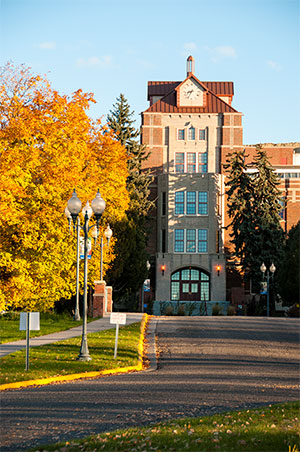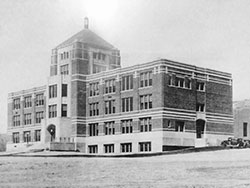University Communications and Marketing
Preserving and renewing a Billings Landmark
November 5, 2015
Contacts:
Tim Urbaniak, 247-3050
Carmen Price, University Communications and Marketing, 657-2266

McMullen Hall at MSU Billings
McMullen Hall at Montana State University Billings, the university’s first building erected in 1935, has been listed on the National Register of Historic Places
MSU BILLINGS NEWS SERVICES — The Montana State University Billings’ iconic McMullen Hall, the 80-year-old landmark at the heart of the university campus, has been added to the National Register of Historic Places.
The federal designation signifies national recognition of the building’s historic and architectural significance.
“This well-deserved recognition affirms our commitment to preserving the rich historical past of MSU Billings as well as our excitement of entering into the next century as stewards of higher education who embrace both past and future generations,” MSUB Chancellor Mark Nook said.
McMullen Hall is central to the story of MSU Billings and the city of Billings.
 The first building constructed on the campus of what was originally called Eastern
Montana Normal School, McMullen Hall was completed in 1935, eight years after the
college opened its doors to its first class of 149 students and 14 faculty members.
Prior to its construction, students attended classes downtown.
The first building constructed on the campus of what was originally called Eastern
Montana Normal School, McMullen Hall was completed in 1935, eight years after the
college opened its doors to its first class of 149 students and 14 faculty members.
Prior to its construction, students attended classes downtown.
A 1935 photo shows the stately building standing in stark contrast to its bare surroundings. Eight decades later, McMullen Hall presides over the beautiful, 110-acre urban university campus of MSU Billings with 16 other buildings.
The Billings Gazette said it best five years ago when the building’s exterior received reclamation: “It took years before foliage and other buildings would fill in the landscape. Now 75 years after it was built, McMullen still commands the hill overlooking Billings. It not only has anchored the university over the decades, it has become a Billings landmark.”
Designed in the Collegiate Gothic style, the four-story, red-orange brick building has a central tower decorated with details including floral medallions and bell-shaped flowers and was designed by well-known Montana architects McIver and Cohagen and built by Frank Jacoby and Sons contractors out of Helena.
The architectural style was widely utilized in the 19th and 20th centuries for academic, political and religious buildings because of the ability to emanate prestige and a strong presence through many different design elements.
Key elements incorporated into McMullen Hall’s architecture that ties into this historically significant movement are the use of recessed entrances framed by arches, stone moldings, towers, buttresses and windows utilizing small panes of glass in tall, narrow proportions.
“The very architectural style of Collegiate Gothic conveys stature and permanence,” said Tim Urbaniak, a City instructor.
Urbaniak, along with MSUB Facilities Services Director Jason McGimpsey, compiled the narrative, photos, maps and drawings required for the national registry application.
“The application process required extensive research and documentation about the architectural distinction and historical and cultural significance of the building,” said Urbaniak, who has served on the Montana Preservation Board for four years.
He said he volunteered for the task as a result of the 2011 Montana Senate Bill 3, charging all state agencies to review their properties to see what heritage buildings they are in charge of and in turn track how the buildings are being cared for.
“It became very evident that no one had yet reviewed our first and foremost building,” said Urbaniak, who has worked for the university for nearly three decades. “It was obviously a heritage building worth the preservation efforts.”
The university received official word on Sept. 28 that the building, which now houses the main administrative departments and student services, had been approved for the listing.
“McMullen Hall has undergone some modernization and has changed uses over the years, but it still retains its architectural integrity,” said McGimpsey, who received his master’s degree in architecture and bachelor’s in environmental design from Montana State University.
The most recent upkeep, McGimpsey said, was in 2010 with a full masonry restoration on the exterior of the building and complete window replacements.
The application to the Register of Historic Places, administered by the National Park Service, details McMullen Hall’s architectural value and local-level of significance, citing the association with “events that have made a significant contribution to the broad patterns of our history, particularly the development of the regional system of higher education…”
At a time when central and eastern Montana was in need of an institution of higher education, the fifth unit of the Montana University System—Eastern Montana State Normal School—was established March 12, 1927 with Dr. Lynn McMullen named as the college’s first president, who was known for his hands-on teaching style and participation at the ground-level.
“The overall history flow and how this university came to be can be attributed to the people of Billings. It was a hard fight to get the university built here over other towns in the central and eastern parts of Montana,” Urbaniak said.
“The university ultimately became the pillar of the community,” he said. “When students came by train in the fall, everyone—students, faculty, staff and the rest of the Billings community— had a parade down to the station where they greeted the students. It was quite a big deal.”
The building’s designation into the National Register of Historic Places honors a significant part of the history of our community, Urbaniak said.
“Through this project, we embrace the university’s past,” he said. “It gives us a chance to immerse ourselves in its history and see things from a bigger picture. We can step back and realize again the role we play in the community. My hope is that it will contribute to looking at what we do well, and how we can take that into the future.”
Built on the hill overlooking Billings, McMullen Hall began with a vision for outstanding education, a center for teaching and scholarship.
“Guided by the Secretary of the Interior’s Standards for Treatment of Historic Properties, MSUB will steward this key piece of our history in a manner which will preserve and maintain the structure for future generations of students, faculty and staff to proudly serve as a key component to our heritage and humble beginnings as Eastern Montana Normal School in 1927 under the leadership of Dr. Lynn B. McMullen,” McGimpsey said.
MSUB’s predecessors, who laid the foundations for the university, and their passion for the transformative power of education, those beliefs took shape, first as a normal school and now as a comprehensive, regional university that emphasizes those same values of access and excellence, Chancellor Nook said.
MSU Billings will soon begin a new century, he said. Its curricula will continue to grow and evolve into programs of study which form the core of Montana’s intellectual, economic and public service sectors, and one that embraces and exemplifies the university’s promise of access and excellence.
As the university lays the foundation for the next century, the mission remains to positively impact our society through students, alumni and colleagues.
“It is important we carry on the commitment to provide a top-notch education to students,” Nook said. “MSUB’s history is a story of dreamers and doers, of opportunity and access. It has a beginning but no end. The story is still being written.”
»» View MSU Billings' application to the National Register of Historic Places
